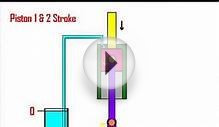
The principle of working of both SI and CI engines are almost the same, except the process of the fuel combustion that occurs in both engines. In SI engines, the burning of fuel occurs by the spark generated by the spark plug located in the cylinder head. The fuel is compressed to high pressures and its combustion takes place at a constant volume. In CI engines the burning of the fuel occurs due to compression of the fuel to excessively high pressures which does not require any spark to initiate the ignition of fuel. In this case the combustion of fuel occurs at constant pressure.
Both SI and CI engines can work either on two-stroke or four stroke cycle. Both the cycles have been described below:
1) Four-stroke engine: In the four-stroke engine the cycle of operations of the engine are completed in four strokes of the piston inside the cylinder. The four strokes of the 4-stroke engine are: suction of fuel, compression of fuel, expansion or power stroke, and exhaust stroke. In 4-stroke engines the power is produced when piston performs expansion stroke. During four strokes of the engine two revolutions of the engine's crankshaft are produced.
2) Two-stroke engine: In case of the 2-stroke, the suction and compression strokes occur at the same time. Similarly, the expansion and exhaust strokes occur at the same time. Power is produced during the expansion stroke. When two strokes of the piston are completed, one revolution of the engine's crankshaft is produced.
In 4-stroke engines the engine burns fuel once for two rotations of the wheel, while in 2-stroke engine the fuel is burnt once for one rotation of the wheel. Hence the efficiency of 4-stroke engines is greater than the 2-stroke engines. However, the power produced by the 2-stroke engines is more than the 4-stroke engines.
RELATED VIDEO












